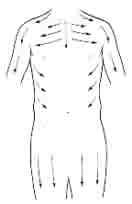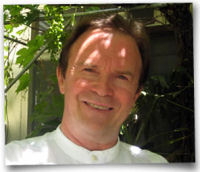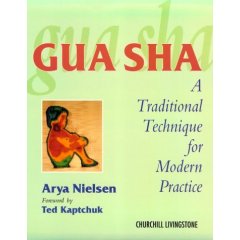Acupuncture Resources
Conditions Treated | Needles | Moxibustion | Cupping | Auriculotherapy | Acupressure | Gua Sha
Gua Sha Therapy
Information provided by Arya Nielsen. www.guasha.com
Arya Nielsen is a professor of East Asian Medicine, Nationally Board Certified in Acupuncture and Chinese Herbal Medicine, a Fellow of the National Academy of Acupuncture and Oriental Medicine, and past Chair of the New York State Board for Acupuncture. She has been in private practice for 25 years, is a Senior Faculty member at the Tri-State College of Acupuncture, Guest Faculty at the Anglo-Dutch Institute of Oriental Medicine in the Netherlands and Adjunct Faculty at Beth Israel Hospital's Continuum Center for Health and Healing in New York City, where she also practices. Arya is the author of Gua Sha: A Traditional Technique for Modern Practice.
What is Gua Sha?
Gua Sha (pronounced "gwa shaw,") is an East Asian healing technique. Gua means to scrape or rub. Sha is a 'reddish, elevated, millet-like skin rash' (aka petechiae). Sha is the term used to describe Blood stasis in the subcutaneous tissue before and after it is raised as petechiae. Gua Sha is one technique that intentionally raises Sha rash or petechiae. In Vietnam the technique is called Cao Yio, in Indonesia: Kerik, in Laos: Khoud Lam.
When is Gua Sha used?Gua Sha is used whenever a patient has pain whether associated with an acute or chronic disorder. . There may be aching, tenderness and/or a knotty feeling in the muscles. Palpation reveals Sha when normal finger pressure on a patient's skin causes blanching that is slow to fade. In addition to resolving musculo skeletal pain, Gua Sha is used to treat as well as prevent common cold, flu, bronchitis, asthma, as well as any chronic disorder involving pain, congestion of Qi and Blood.

 Where is Gua Sha applied?
Where is Gua Sha applied?
Sha is raised primarily at the Yang surface of the body: the back, neck, shoulders, buttocks, and limbs. On occasion, Gua Sha is applied at the chest and abdomen.
How is Gua Sha applied?To apply gua sha, first lubricate the area with oil. If you do not have gua sha oil, you can use White Flower or any other oil. If there are any moles, cuts or unhealed areas, cover them with your fingers. Do not apply the gua sha tool to these kinds of areas. Hold the gua sha tool at a thirty degree angle to the skin, the smooth edge will touch the skin. The skin is then rubbed with a round-edged instrument in downward strokes. One area is stroked until the petechiae that surface are completely raised. If there is no Blood stasis the petechiae will not form and the skin will only turn pink.
Gua Sha stroke areasRub the skin in downward strokes using moderate pressure. The person should not feel pain although it might feel uncomfortable. Stroke one area at a time, until the petechia of that surface is completely raised and all the sha is up, which is when stroking no longer increases the number of dots or changes the color. Then move to the next area. The sha petechiae should fade in about 2-4 days. If it is very slow to fade, it indicates poor blood circulation and there may be more serious deficiency that will require additional treatments with combination of acupuncture or acupressure in specific areas. Gua sha treatment can be used up to three times weekly, and is most effective when used as a weekly treatment on chronic conditions.
What kind of instrument is used to Gua Sha?A soupspoon, coin, or slice of water buffalo horn is used in Asia.
What does the type of Sha indicate?The color of the Sha is both diagnostic and prognostic. Very light colored Sha can indicate Deficiency of Blood. If the Sha is fresh red, it is of recent penetration. If the Sha is purple or black, the Blood stasis is long-standing. If brown, the Blood may be dry. Dark red Sha can indicate heat.
How fast will the petechiae fade?The Sha petechiae should fade in 2-4 days. If it is slower to fade, indicating poor Blood circulation, the practitioner must ascertain whether it is deficiency of Blood, Qi or Yang, a deeper stagnation or organ deficiency at the root.
What are the benefits of Gua Sha?In most cases the patient feels an immediate shift in their condition particularly in their pain or sense of constraint. Gua Sha moves stuck Qi and Blood, releases the Exterior mimicking sweating, and moves Fluids. In a modern medical construct these fluids contain metabolic waste that congested the surface tissues and muscles. Gua Sha promotes circulation and normalizes metabolic processes. It is a valuable treatment for both external and internal pain, and facilitates the resolution of both acute and chronic disorders.
Is Gua Sha Safe?Gua Sha is a completely safe technique, but it is serious medicine. Knowing when to use it and what to expect from treatment is as important as good technique. People who live in chronic pain often erect emotional defenses to cope with it or can feel completely hopeless. Having that pain ‘touched’ and relieved can be unsettling, even shocking. It is good to be moderate in activity after treatment, even rest. After treatment: no drugs, booze, sex, fasting, feasting or hard labor, including working out, for the rest of the day. In other words, mellow mode.

Bruce Bentley - Health Traditions
Articles
Gua Sha : Smoothly scraping out the Sha.
The Subtle Cup - practice of cupping.
A Brief History of Cupping.
We provide fully accredited courses that deliver exceptional information and practical hands-on training in a friendly, creative environment. Cupping is a specialized method of treatment that requires expert instruction, backed by the kind of deep interest and decades of research and practice that inspired us to present the World's First Cupping (and Gua Sha) workshops. After completing our Master Class in Traditional East-West Cupping and Remedial Cupping, students are also awarded an Advanced Certificate in Integrated Cupping Therapy. We were also the first to teach Traditional Thai Massage in the West and remain the only school outside Thailand to be recommended by the Wat Pho School of Traditional Thai Massage (Headquarters of TTM in Thailand).
Gua Sha: A Traditional Technique for Modern Practice
 Gua Sha: A Traditional Technique for Modern Practice
Gua Sha: A Traditional Technique for Modern Practice
Check New and Used Prices
by Arya Nielsen
Description
This is the first English language book on the ancient therapeutic technique 'Gua Sha'. It is a technique commonly used in Asia and Southeast Asia by TCM practitioners, Chinese families and individuals who know and use it as part of their 'health culture'. In Gua Sha, the skin is pressured in strokes i.e. scraped (but not broken) by a blunt edge (Chinese families used a spoon). This, in Western terms, raises extravasated blood and metabolic waste which collects in muscle tissue, and encourages its departure. Gua Sha is often used to counteract muscle strain through athletic injury, back pain, and conditions beyond muscle injury alone. The result, visually, is livid discolouration of the skin which subsides in a few days, considerably faster than a bruise. For this reason practitioners in the West have been afraid of using it. However it can be a very useful technique to know how to use, and will enhance the skills of any practitioner using it while giving them another treatment method to help increase their clinical skills.This book brings the technique alive for Western practitioners, with clear discussion of how to do it - including correct technique, appropriate application, and difficulties to bear in mind - and when to use it, and superb colour illustrations and specially commissioned line drawings to demonstrate the technique. The author is an expert practitioner of 'Gua Sha'.